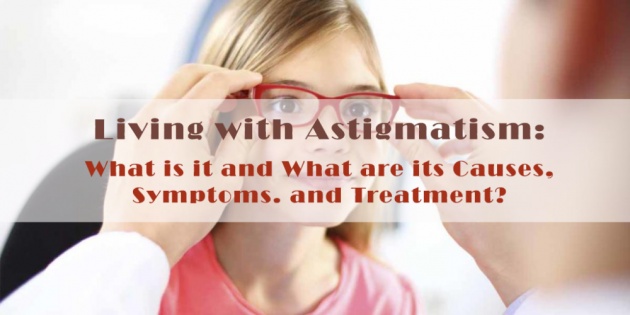
Image Credit: https://vips.org/education/ / Edited with Photoshop
Late last year, we found out that my son has an eye condition. He was diagnosed with myopia (nearsightedness) and astigmatism at age 1 and a half years old. It was probably inborn since I also suffer from the same eye conditions--plus, he was born prematurely. All of those factors played a role in his current eye condition. However, did you know that astigmatism is more common than we think? This is the reason why I wanted to tackle astigmatism more in this blog post--to spread more awareness about this condition and to encourage parents to have their children's eyes checked every once in a while even if nothing seems wrong.
Astigmatism is such a big word and it does sound ominous. So when you're eye doctor tells you that you have this eye condition, you may be at a loss or even become scared. But, don't worry. It's not really as scary as you may think. Although it is not a fatal health condition, you should still have it treated. If you ignore it, it may lead to other more serious eye conditions. I overheard one patient at the eye doctor's clinic. He said that his astigmatism was so severe, he is in danger of going blind because the cornea of his eyes might rip apart. Yikes! Scary! Hmm. So, you may be wondering what this astigmatism really is about. Let's learn about the causes, symptoms, and treatment for astigmatism.
✤ What is Astigmatism? ✤
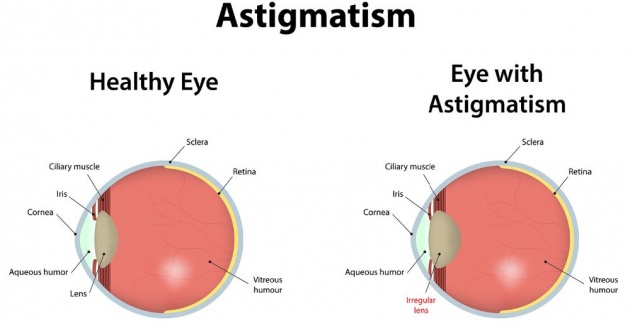
Image Credit: https://www.aoa.org/
Simply put, astigmatism is a type of refractive error--the same as myopia (nearsightedness) and hyperopia (farsightedness). But, let's go a little deeper than that, shall we?
The eye's cornea or lens is normally smooth, round, and equally curved in all directions which helps focus and bend the light that comes into contact with it evenly. This helps give us a clear view. However, the cornea or lens of people with astigmatism is not as round as they should be. This means light is not refracted properly, causing blurry vision.
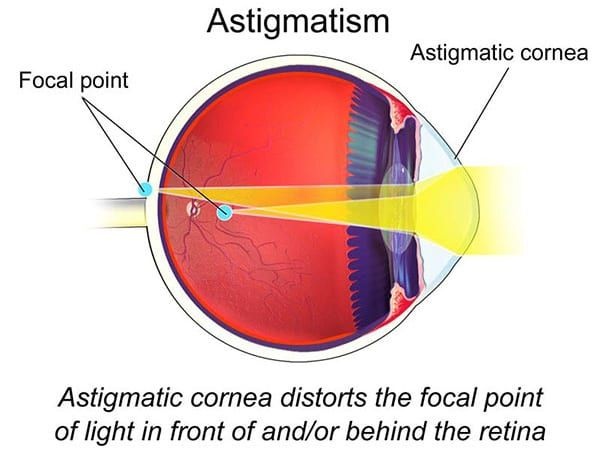
Image Credit: https://www.rosineyecare.com/
There are basically two kinds of astigmatism, corneal and lenticular, depending on which part of your eyes are not shaped properly. Either way, both types of astigmatism causes your sight to be blurry or distorted for both near and far objects. Most people suffer from astigmatism combined with other refractive errors--like me. I have myopia and astigmatism.
✤ Types of Astigmatism ✤
✤ Myopic astigmatism
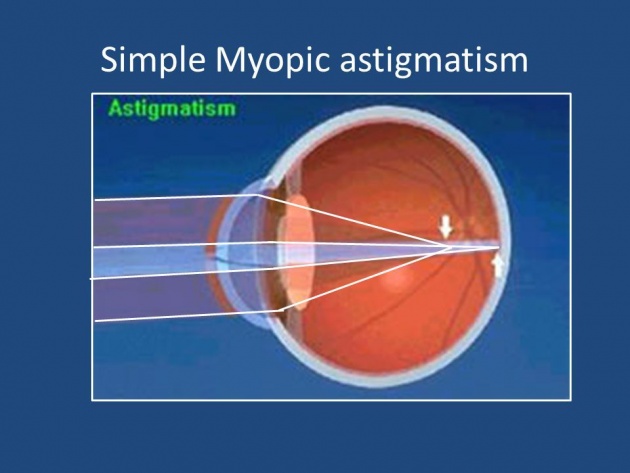
Image Credit: https://slideplayer.com/
In this type of astigmatism, one or both principal meridians are nearsighted. The eyes can be myopic in differing degree if both meridians are myopic.
✤ Hyperopic Astigmatism
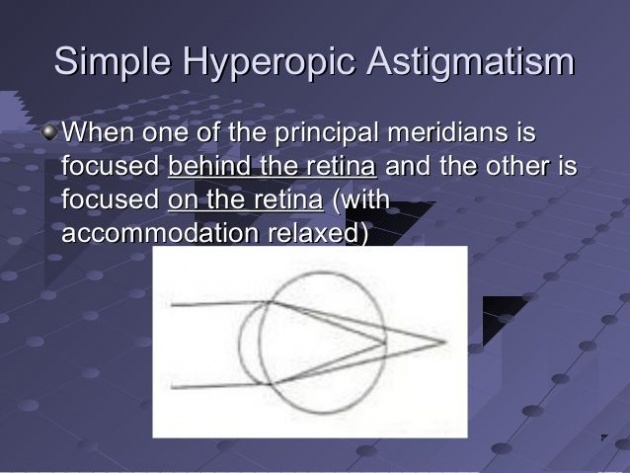
Image Credit: https://www.slideshare.net/
In contrast to myopic astigmatism, hyperopic astigmatism is when one or both principal meridians of the eyes are farsighted.
✤ Mixed astigmatism
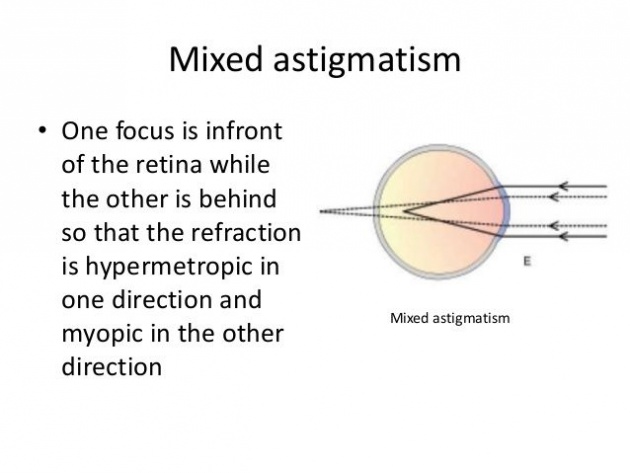
Image Credit: https://www.slideshare.net/
As the name implies, mixed astigmatism is when one prinicipal meridean is farsighted and the other is nearsighted.
✤ Common Causes of Astigmatism ✤
Astigmatism is normally caused by an irregularly shaped cornea--and most people who have it are born with it. However, nobody knows exactly why some people are born with and some aren't. Although, genetics play a significant role in this. Premature babies are also more prone to astigmatism. A good example would be my son. I have astigmatism and so does he--plus, he was born prematurely.
Eye injuries, diseases, and surgeries also increase your risk of developing astigmatism. Rubbing your eyes excessively can also damage the cornea and lens of your eyes, causing astigmatism.

Image Credit: https://www.eyeque.com/
It's also important to note that reading in low light or sitting too close to the television does not cause astigmatism. But, that doesn't mean you should do any of these activities.
✤ What are the Symptoms of Astigmatism? ✤
Some of the most common symptoms of astigmatism include one or more of the following.
- Blurry or distorted vision
- Eyestrain or eye discomfort
- Squinting of the eyes in order to see clearly
- Headaches
If you experience any of the symptoms mentioned above, do not hesitate to visit an eye doctor for a complete eye exam. This will greatly help determine what's causing your problem.
✤ How is Astigmatism Diagnosed? ✤
Astigmatism is diagnosed through a comprehensive eye exam. This will allow your doctor to diagnose what type of astigmatism you have and if there are other more serious problems to check. Astigmatism symptoms also usually come on slowly, so you may not be aware that you already have it. It would be best to consult with your eye doctor once you notice any changes in your vision, no matter how small it is.
✤ What are the Treatments for Astigmatism? ✤
Most cases of astigmatism can be corrected with the use of contact lenses or glasses. However, if it's just a slight astigmatism without any other vision problems, your doctor may allow you to not use corrective glasses or contacts anymore.
Irregular astigmatism, on the other hand, is far less common but needs more attention. This is usually linked to problems with the cornea or the front of the eye. A common condition is keratoconus where the cornea is cone-shaped instead of round.
Common treatments for regular astigmatism include the following.
✤ Corrective lenses

Image Credit: Pexels via Pixabay
Corrective lenses include glasses or contacts. If you're more into contact lenses than eyeglasses, your eye doctor will most likely prescribe you with a toric contact lens, a special type of soft contact lenses. These contact lenses are specially made to bend light in one direction or the other according to your needs. However, for more severe cases, you may need to wear a gas-permeable rigid contact lens. Your doctor will come up with the best solution for you.
✤ Refractive surgery

Image Credit: https://www.advancedvisioncare.co.uk/
If you want a more permanent solution to your astigmatism, you can try laser surgery. This surgery has the ability to change the shape of your cornea to make it rounder. There are several types of laser surgery. But, don't worry. Your doctor should be able to recommend the best one for you. However, before you can qualify for a laser surgery, you will need to have healthy eyes, without corneal scars or retina problems.
Here is Dr. Joseph Allen for Doctor Eye Health to talk more about astigmatism.
Video Credit: Doctor Eye Health via Youtube
✤ Concluding Thoughts ✤
Exposure to computer, TV, and cellphone screens does not cause astigmatism but that doesn't mean they cannot affect our eyesight. So, it is still best to see an eye doctor every once in a while even if you've always had a healthy pair of eyes with 20/20 vision.
~~oO0Oo~~oO0Oo~~oO0Oo~~
Thanks for reading! Have a wonderful day ahead of you and keep smiling. :)
Written by Chineyes for bitLanders
For more quality blog posts, you may visit my page
Not yet on bitLanders? Sign up now and be rewarded for sharing ideas, photos, and videos!



